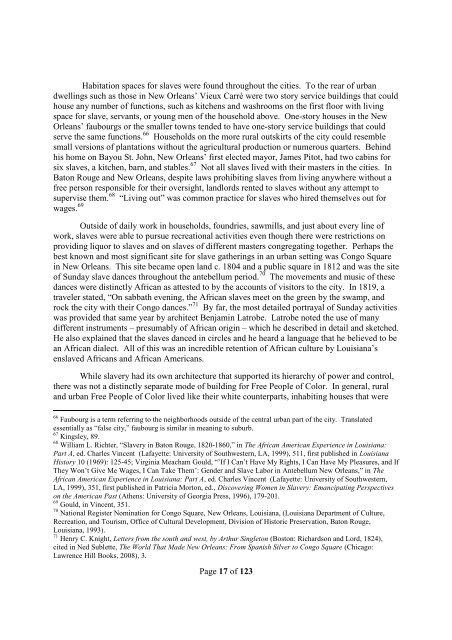The African American Experience in Louisiana
The_African_American_Experience_in_Louisiana
The_African_American_Experience_in_Louisiana
- No tags were found...
Create successful ePaper yourself
Turn your PDF publications into a flip-book with our unique Google optimized e-Paper software.
Habitation spaces for slaves were found throughout the cities. To the rear of urban<br />
dwell<strong>in</strong>gs such as those <strong>in</strong> New Orleans’ Vieux Carré were two story service build<strong>in</strong>gs that could<br />
house any number of functions, such as kitchens and washrooms on the first floor with liv<strong>in</strong>g<br />
space for slave, servants, or young men of the household above. One-story houses <strong>in</strong> the New<br />
Orleans’ faubourgs or the smaller towns tended to have one-story service build<strong>in</strong>gs that could<br />
serve the same functions. 66 Households on the more rural outskirts of the city could resemble<br />
small versions of plantations without the agricultural production or numerous quarters. Beh<strong>in</strong>d<br />
his home on Bayou St. John, New Orleans’ first elected mayor, James Pitot, had two cab<strong>in</strong>s for<br />
six slaves, a kitchen, barn, and stables. 67 Not all slaves lived with their masters <strong>in</strong> the cities. In<br />
Baton Rouge and New Orleans, despite laws prohibit<strong>in</strong>g slaves from liv<strong>in</strong>g anywhere without a<br />
free person responsible for their oversight, landlords rented to slaves without any attempt to<br />
supervise them. 68<br />
“Liv<strong>in</strong>g out” was common practice for slaves who hired themselves out for<br />
wages. 69 Outside of daily work <strong>in</strong> households, foundries, sawmills, and just about every l<strong>in</strong>e of<br />
work, slaves were able to pursue recreational activities even though there were restrictions on<br />
provid<strong>in</strong>g liquor to slaves and on slaves of different masters congregat<strong>in</strong>g together. Perhaps the<br />
best known and most significant site for slave gather<strong>in</strong>gs <strong>in</strong> an urban sett<strong>in</strong>g was Congo Square<br />
<strong>in</strong> New Orleans. This site became open land c. 1804 and a public square <strong>in</strong> 1812 and was the site<br />
of Sunday slave dances throughout the antebellum period. 70 <strong>The</strong> movements and music of these<br />
dances were dist<strong>in</strong>ctly <strong>African</strong> as attested to by the accounts of visitors to the city. In 1819, a<br />
traveler stated, “On sabbath even<strong>in</strong>g, the <strong>African</strong> slaves meet on the green by the swamp, and<br />
rock the city with their Congo dances.” 71 By far, the most detailed portrayal of Sunday activities<br />
was provided that same year by architect Benjam<strong>in</strong> Latrobe. Latrobe noted the use of many<br />
different <strong>in</strong>struments – presumably of <strong>African</strong> orig<strong>in</strong> – which he described <strong>in</strong> detail and sketched.<br />
He also expla<strong>in</strong>ed that the slaves danced <strong>in</strong> circles and he heard a language that he believed to be<br />
an <strong>African</strong> dialect. All of this was an <strong>in</strong>credible retention of <strong>African</strong> culture by <strong>Louisiana</strong>’s<br />
enslaved <strong>African</strong>s and <strong>African</strong> <strong>American</strong>s.<br />
While slavery had its own architecture that supported its hierarchy of power and control,<br />
there was not a dist<strong>in</strong>ctly separate mode of build<strong>in</strong>g for Free People of Color. In general, rural<br />
and urban Free People of Color lived like their white counterparts, <strong>in</strong>habit<strong>in</strong>g houses that were<br />
66 Faubourg is a term referr<strong>in</strong>g to the neighborhoods outside of the central urban part of the city. Translated<br />
essentially as “false city,” faubourg is similar <strong>in</strong> mean<strong>in</strong>g to suburb.<br />
67 K<strong>in</strong>gsley, 89.<br />
68 William L. Richter, “Slavery <strong>in</strong> Baton Rouge, 1820-1860,” <strong>in</strong> <strong>The</strong> <strong>African</strong> <strong>American</strong> <strong>Experience</strong> <strong>in</strong> <strong>Louisiana</strong>:<br />
Part A, ed. Charles V<strong>in</strong>cent (Lafayette: University of Southwestern, LA, 1999), 511, first published <strong>in</strong> <strong>Louisiana</strong><br />
History 10 (1969): 125-45; Virg<strong>in</strong>ia Meacham Gould, “’If I Can’t Have My Rights, I Can Have My Pleasures, and If<br />
<strong>The</strong>y Won’t Give Me Wages, I Can Take <strong>The</strong>m’: Gender and Slave Labor <strong>in</strong> Antebellum New Orleans,” <strong>in</strong> <strong>The</strong><br />
<strong>African</strong> <strong>American</strong> <strong>Experience</strong> <strong>in</strong> <strong>Louisiana</strong>: Part A, ed. Charles V<strong>in</strong>cent (Lafayette: University of Southwestern,<br />
LA, 1999), 351, first published <strong>in</strong> Patricia Morton, ed., Discover<strong>in</strong>g Women <strong>in</strong> Slavery: Emancipat<strong>in</strong>g Perspectives<br />
on the <strong>American</strong> Past (Athens: University of Georgia Press, 1996), 179-201.<br />
69 Gould, <strong>in</strong> V<strong>in</strong>cent, 351.<br />
70 National Register Nom<strong>in</strong>ation for Congo Square, New Orleans, <strong>Louisiana</strong>, (<strong>Louisiana</strong> Department of Culture,<br />
Recreation, and Tourism, Office of Cultural Development, Division of Historic Preservation, Baton Rouge,<br />
<strong>Louisiana</strong>, 1993).<br />
71 Henry C. Knight, Letters from the south and west, by Arthur S<strong>in</strong>gleton (Boston: Richardson and Lord, 1824),<br />
cited <strong>in</strong> Ned Sublette, <strong>The</strong> World That Made New Orleans: From Spanish Silver to Congo Square (Chicago:<br />
Lawrence Hill Books, 2008), 3.<br />
Page 17 of 123


